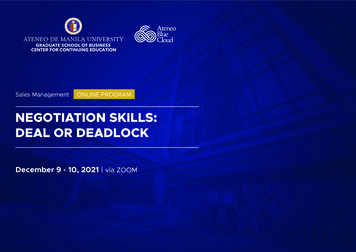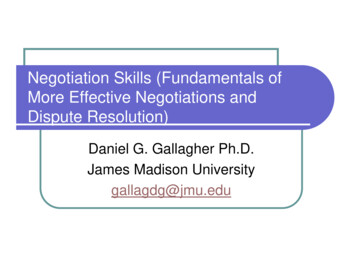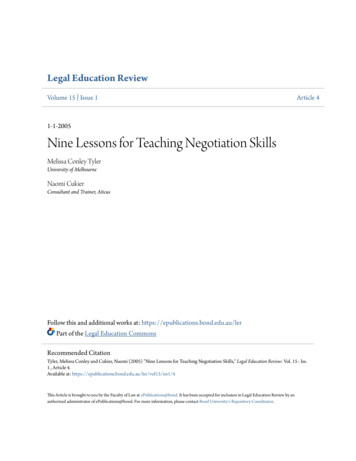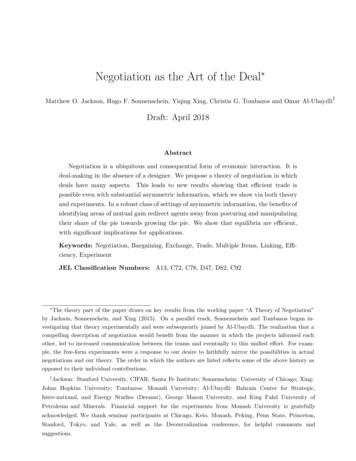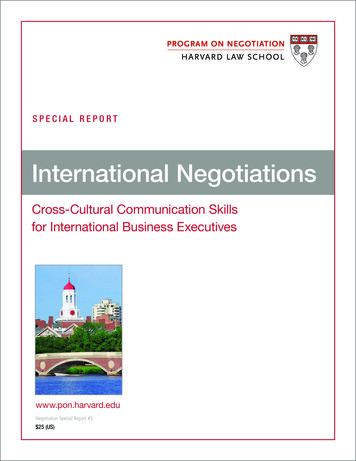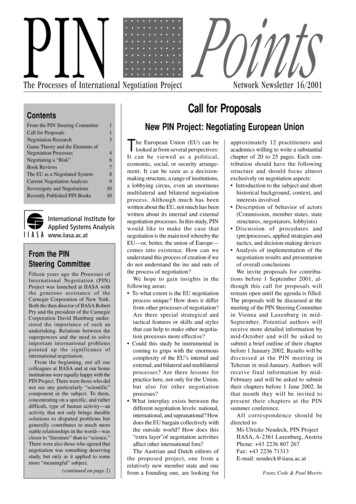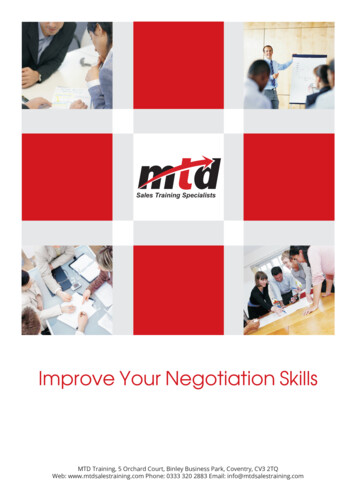
Transcription
Sales Training SpecialistsImprove Your Negotiation SkillsMTD Training, 5 Orchard Court, Binley Business Park, Coventry, CV3 2TQWeb: www.mtdsalestraining.com Phone: 0333 320 2883 Email: info@mtdsalestraining.com
What negotiation isand why it is importantNegotiation: can be defined as a process of bargaining by which agreement is reachedbetween 2 or more parties. We all negotiate every day in a wide range of work and socialsituations. It is important to know how to negotiate for a number of reasons:Effect on ProfitsDuring the negotiation course, we will explore why negotiating skills are important for you to besuccessful in business and in life. The importance of negotiation to your business is vital and theimpact of good or bad negotiating can be shown as follows:Company ASales 10mCosts8mProfit 2mCompany BSales 10mCosts8mProfit 2mAssume Company A has sales people and buyers who by improved negotiating techniquesincrease sales by 5% and reduce costs by 5%.Company ASales 10mCosts8mProfit 2mCompany BSales 10.5Costs7.6mProfit 2.9mBy achieving relatively modest improvements in buyers’ and sellers’ performance, the effectis an increase in profits of 0.9m. This represents a 45% increase over the previous profit figure.Effect on CustomersSuccessful negotiations can lead to increased profits, but can also lead to greater customersatisfaction. For example, you are buying a second car and you see a car advertised in thepaper for 8,500. You decide to make an ambitious offer to see how they react. You offer 6,000 and they accept your offer immediately. How do you feel?Web: www.mtdsalestraining.com Telephone: 0333 320 28832
What negotiation isand why it is importantMost people feel two things in quick succession:1. I could have done better2. There must be something wrong with the carThink of this next time you are negotiating for your business with a customer or supplier. Are you being fair’ by offering your best price first time? What impact has your action had on the waythe other side feels?The objective of successful negotiation is not necessarily to charge the highest possible pricesfor your products, or to pay the minimum price possible for your supplies, but to creatively puttogether solutions to problems that ensure: The best possible outcome for your business. Customers and suppliers who are happy to do business with you. A reputation for being a tough negotiator while earning the respect of those with whom younegotiate.Web: www.mtdsalestraining.com Telephone: 0333 320 28833
Adversarial versusco-operative bargainingOur style of negotiation will be influenced by the style of the other party. If both sides are adversarial,there will be little trust between the two parties, however, if one side decides to be co-operative, thereis a danger the other side will use this apparent sign of weakness to their advantage.Co-operative bargaining has the advantage of being a more efficient style of negotiation, howevercertain rules have to be followed by both parties, for it to work.Let us look at the 2 styles of bargaining and their features:Features of adversarial bargaining Each side takes up a position and defends itOpening bids are set at unrealistic levels; too high or too low, in order to give room for manoeuvreMovement is small or non-existent until later on in the negotiationTactics are used to gain short term advantageToo much emphasis is placed on trust. “This really is my best price!”Information is withheld, or misrepresentedThe outcome is often win-lose, or lose-loseThe more aggressive negotiator usually does bestThis style does not encourage long term, mutually beneficial relationshipsNeither side asks enough questions, or explores alternatives in sufficient depthFeatures of co-operative bargaining Each side recognises that the other has needs and feelings and accepts implicit rulesObjective measures are taken of what is fair and reasonableTrust is not an issue as either side is willing to share informationThis style is friendly, but not soft. There is a willingness to trade concessionsThere is a clear, communicable strategyBad behaviour is punishedThis style involves creative problem solvingIt encourages long term, mutually profitable relationshipsEach side asks more questions and explores alternatives, rather than taking up fixed positionsThe usual outcome is win-win“The objective of negotiation is not a dead opponent”: NapoleonWeb: www.mtdsalestraining.com Telephone: 0333 320 28834
Planning the negotiationIn any kind of negotiation the planning stage is probably the most important. Too often in negotiationswe go in badly prepared and end up giving concessions that reduce the overall profitability of the finaldeal. The importance of planning is in having a very clear idea before entering into the negotiation.1. What are my objectives?2. What does the other side wish to achieve?3. What information will influence the final outcome of the negotiation?4. What concessions can I make?5. How am I going to achieve my objectives?6. What part will other people play in the negotiation?Generally, the more time that is spent in planning and preparing for the negotiation, the more beneficialwill be the final outcome.ObjectivesBefore entering into the negotiation, you need to have a clear idea of your objectives and try to workout those of the other side. Ask yourself the following questions:1. What exactly do I wish to achieve from this negotiation?2. Which of my objectives:a. Must I achieve?b. Do I intend to achieve?c. Would I like to achieve?3. What options or alternatives would be acceptable to me?4. What are the other sides’ objectives?5. How does the other side see the negotiation?Web: www.mtdsalestraining.com Telephone: 0333 320 28835
Planning the negotiationInformationIt has often been said that information is power. In any negotiation, there will be 4 types of informationthat is important to the final outcome.1. What information do I have that the other side has also?2. What information do I have that the other side does not have?3. What information do I need to have before negotiating with the other side?4. What information does the other side need before it can negotiate with me?This can be particularly important when negotiating with people who concentrate on price issues. Whatother things are important to this person? What pressures does he have on him to conclude the deal?How well is his company doing at the moment? How important is it that he deals with my company?etc.The early phases of negotiation consist of both sides finding out more information before talking abouta specific deal or set of alternatives. For example, if you find out the other side has a time deadline thatonly your company can meet, it may give you the chance to negotiate on more favourable price. Ifyou know that the other side has recently expanded their production capacity, you may be able tonegotiate more favourable terms in return for a commitment to buy certain volumes over an agreedtime period.By spending time as part of your preparation in listing what you already know and what you need toknow, you will give yourself a better chance to negotiate well on your company’s behalf.ConcessionsNegotiating is a process of bargaining by which agreement is reached between two or more parties.It is rare in negotiation for agreement to be reached immediately or for each side to have identicalobjectives. More often than not, agreements have to be worked out where concessions are given andreceived and this is the area where the profitability of the final outcome will be decided.When preparing for negotiation, it is advisable to write down a realistic assessment of how you perceivethe final outcome, find out the limits of your authority within the negotiation and decide what you arewilling and able to concede in order to arrive at an agreement which satisfies all parties.Concessions have two elements; cost and value. It is possible during negotiations to concede issuesthat have little cost to you but have great value to the other side. This is the best type of concession tomake. Avoid, however, conceding on issues that have a high cost to you irrespective of their value tothe other side.Web: www.mtdsalestraining.com Telephone: 0333 320 28836
Planning the negotiationWhen preparing for negotiations, ask yourself the following questions:1. What is the best deal I could realistically achieve in this negotiation?2. What is the likely outcome of the negotiation?3. What is the limit of my authority? At which point should I walk away?4. What concessions are available to me? What is the cost of each concession and what value doeseach have to either side?StrategyPlanning your strategy is important in negotiation. Once you know your objectives, you need to workout how you are going to achieve them. It is also useful to try and see the negotiation from the otherside and try and work out what their strategy will be.During the negotiation there will be opportunities to use various tactics and you need to decide onwhich of these you feel comfortable with and recognise the tactics being used by the other side. Askyourself the following questions:1. How am I going to achieve my objectives in this negotiation?2. What is the strategy of the other side likely to be?3. What tactics should I use within the negotiation?4. What tactics are the other side likely to use?TasksIf you go into negotiation with a colleague or colleagues, you need to decide during the preparationphase:1. What role will each team member take in the negotiation?2. How can we work together in the most effective way?Some teams of negotiators appoint team leaders, note takers, observers and specialists, each withtheir own clearly defined authority and roles to perform. Having a clear understanding of roles withinthe negotiation will make the team approach much more effective.Web: www.mtdsalestraining.com Telephone: 0333 320 28837
Preparing for negotiationsLike, intend and must positionsThe best deal, like:1.6.2.7.3.8.4.9.5.10.An acceptable deal, intend:1.6.2.7.3.8.4.9.5.10.The worst acceptable deal, must:1.6.2.7.3.8.4.9.5.10.Web: www.mtdsalestraining.com Telephone: 0333 320 28838
Structuring the negotiationPeople who are successful negotiators have a well thought out strategy before going into thenegotiation, are well prepared, self confident and structure the negotiation, so that they remain incontrol of the negotiating process.The recommended structure for negotiations is: Establish the issues being negotiated Gather information Build a solutionStage 1. Establish the issues Many negotiators make the mistake of negotiating too quickly Skilled negotiators spend 20% more of their time asking questions and looking for alternatives Professional negotiators will want to gain your commitment on issues, such as price, early on in thenegotiation You should never commit yourself to anything until you have established everything that is beingnegotiated Negotiators will often bring up an issue at the end of the negotiation, when you are vulnerable andlikely to agree to a ‘ one sided ‘ concession, in order to conclude the deal Skilled negotiators will often ask the other side for their ‘ shopping list ‘ before beginning the negotiationand refuse to accept any last minute additions to the list Issues will include things like price, delivery schedule, payment terms, packaging, quality of product,length of contract etc. At this stage issues are kept general and no concessions are made or agreements reachedStage 2. Gather informationThis is a vital part of the negotiation. There are 4 kinds of information1. Information you have that you are willing to give to the other side2. Information you have that you are unwilling to give to the other side3. Information the other side has that they are willing to give you4. Information the other side has that they are unwilling to give youWeb: www.mtdsalestraining.com Telephone: 0333 320 28839
Structuring the negotiation You need to decide, before the negotiation, how much you are willing to share information andwhat your own information requirements are This will set the climate for negotiation and will determine the amount of trust that exists betweenboth parties Skilled negotiators are able to ask a range of open, closed and follow up questions and are able tolisten effectively Skilled negotiators wait until they have all their information requirements, before making concessionsStage 3. Build a solution Having gathered information the next stage is to begin to put together a solutionUsually this will take the form of the selling side putting forward a proposal, or opening bidThe opening bid should be ambitious, but defensibleYou should always challenge an opening bid and refuse to let an unacceptable bid on the tableThere will then be a process of bargaining and concessions will be traded and movement takeplace, until, hopefully, agreement is reached Concessions should not be given away for free and you should be wary about conceding on issuesfor which you are not preparedWeb: www.mtdsalestraining.com Telephone: 0333 320 288310
Negotiating TacticsMost successful negotiators recognise that the way people involved in negotiations behave does notalways reflect their true feelings or intentions. We are going to look at negotiating tactics that may beused by you or on you. Whether or not you choose to use these tactics, it is vital to understand 3 things: These tactics work They can be being used on you, and can be used by you Once they are recognised as tactics, their effects are reduced, or eliminatedYou may feel that there is no need in your particular case to negotiate or resort to tactics’ in negotiation.This is a matter of personal choice.In general, tactics are used to gain a short-term advantage during the negotiation and are designedto lower your expectations of reaching a successful conclusion.There are many tactics available to negotiators. Here are some you may recognise.Pre-conditioningThis can begin before you even get together, or start your negotiations with the other party. Let us takea sales example:You telephone for the appointment and the other side says, aggressively:“Don’t bother coming if you are going to tell me about price increases. You’ll be wastingyour time and I will be forced to speak to your competitors!”When you do arrive you are kept waiting in reception for half an hour, without being told why. As youwalk through the door into the other person’s office they indicate for you to sit down, but don’t look up.Instead, they sit leafing through your competitor’s brochure, in silence, ignoring your efforts to makeconversation.You are given an uncomfortable low chair to sit in that happens to be directly in line with the sun,shining into the office. At this stage, how confident do you feel?Web: www.mtdsalestraining.com Telephone: 0333 320 288311
Negotiating TacticsThe monkey on the backSome negotiators have the irritating habit of handing their problems to you so that they become yourproblems. This is the monkey on their back that they want you to carry around for them.A classic example is the person who says I have only got 10,000 in my budget. This is often used tacticallyto force a price reduction. Here is what you can do.When one side says I have only 10,000 in budget, look worried. Say something like:That is a problem. As you are no doubt aware, the cost of our systems can be anythingup to 20,000 and I really want to help you choose the best system that meets yourneeds. Does that mean that if one of our systems has everything you are looking for, butcosts 20,000, you would rather I didn’t show it to you?The monkey is now on the other person’s back and they have to make a choice. If the objection isgenuine and the budget figure is correct, you must try to look for an alternative that meets your needsas well as theirs. If they genuinely can only spend 10,000 that is not a tactic but the truth. In dealing withtactics the first decision you must make is whether it is a tactic or a genuine situation. If it is genuine, youhave a problem to solve, rather than a tactic to overcome.The use of higher authorityThis can be a most effective way to reduce pressure in the negotiation by introducing an unseen thirdparty and can also be effective in bringing the negotiation to a close. I need to have this agreed bymy Board of Directors. If they agree to the terms we have discussed, do we have a deal? Be carefulto use this device sparingly so that the other side does not begin to feel you have no decision-makingauthority yourself.One way of countering this tactic is to say before the bargaining begins If this proposal meets yourneeds, is there any reason you would not give me your decision today? If the other side still wishesto resort to higher authority appeal to their ego by saying Of course, they will go along with yourrecommendations, won’t they? Will you be recommending this proposal?NibblingNegotiations can be a tiring process. As the point draws near when an agreement is likely, both sidesexhibit a psychological need to reach agreement and get on with something else.You are very vulnerable as the other side reaches for their pen to sign the order form or contract toconcede items that don’t significantly affect the final outcome.Web: www.mtdsalestraining.com Telephone: 0333 320 288312
Negotiating TacticsOh, by the way, this does include free delivery, doesn’t it?Oh, by the way, the price of the car does include a full tank of petrol?Nibbles work best when they are small and asked for at the right psychological moment. Like peanuts,eat enough of them and they get fattening.This tactic is sometimes seen in retail outlets when you have decided to buy a particular shirt and thesalesperson says of course you’ll be needing a tie to go with the shirt and, before long, you are coercedinto buying much more than you intended. Good negotiators will often keep back certain items ontheir ‘want list’ to the very last minute when the other party is vulnerable. Watch out for this.The good guy and the bad guyYou may have come across this tactic before or else seen it used in films or on television. This is a tacticdesigned to soften you up in the negotiation.For example, you are negotiating the renewal of your service contract with the Buying Director and hisFinance Director. You present your proposal and the Buying Director suddenly gets angry and walksout in disgust muttering to himself about how unfair you have been and how the relationship’ is welland truly over.You pick up your briefcase and are being shown the door when the Finance Director smiles at yousympathetically and saysI’m terribly sorry about that. He is under a lot of pressure. I would like to help you renewyour contract, but he really will not consider the price you have suggested. Why don’t Igo and talk to him for you and see if we can agree a compromise? What is the bottomline on the contract? If you give me your very best price, I will see what I can do.The best way of dealing with this tactic is to recognise the game that is being played and assess exactlywhat the quality of the relationship is. You may be able to say something like:Come off it, you are using good guy, bad guy. You’re a superb negotiator, but let’s sitdown and discuss the proposal realistically .If you don’t have this kind of relationship, stand firm and insist on dealing with the bad guy, or else bluffyourself and give a figure that is within your acceptable range of alternatives.One way of combining good guy, bad guy’ with higher authority’ is by saying things likeWeb: www.mtdsalestraining.com Telephone: 0333 320 288313
Negotiating TacticsWell, I’d love to do a deal with you on that basis, but my manager refuses to let meagree terms of this nature without referring back and he refuses to talk to salespeople.Give me your best price and I will see what I can do .Body languageIt is important in negotiation to react verbally and visually when offers are made. You may have seenthe more theatrical negotiators hang their heads in despair or accuse you of being unfair and souring aperfectly good relationship when you present your proposal. Human nature is such that we can believeand accept these outbursts against us and our negotiating position becomes weaker as a result.Ensure the next time you are in a negotiation that you react to the other party’s offer. If you show noreaction, they may be tempted to ask for more and more and you will lose the initiative in the negotiation.Also, it is almost certain that their opening offer is higher than the figure for which they are prepared tosettle, so it is important that you clearly signal your unwillingness to accept the opening position.If you reach the point below which you will not go, it is important that you show this with your bodylanguage. News readers, when they have finished reading the news, have a habit of picking up theirscript and tidying up their papers. This tells the world that they have finished their task and are preparingto leave. Similarly, when you make your final offer, it can be very powerful to collect your paperstogether and indicate with your body that it really is your final offer. Put your pen away, sit back in yourchair and remain silent. Look concerned and keep quiet.If your voice says final offer but your body is saying let’s keep talking, the other party will disregard whatyou say and keep negotiating.The use of silenceDuring the negotiation, you may make a proposal and find the other party remains silent. This can bevery difficult to handle and often signals disapproval’ to the inexperienced negotiator. Just as natureabhors a vacuum, so silence induces the need in people to talk.If you have a proposal to make, make it and ask the other side how he, or she feels about it. Havingasked the question, sit back and wait for the answer. Whatever you do, don’t change your offer as thiscould seriously weaken your position.The viceA common technique used by negotiators when presented with a proposal is to say You’ll have to dobetter than that. This can be a very powerful statement, especially when used with broken record.Web: www.mtdsalestraining.com Telephone: 0333 320 288314
Negotiating TacticsThe most powerful way of dealing with this is to ask them to be more specific. Whatever you do, don’tweaken your negotiating position in response to the vice by giving anything away, too easily. This willonly encourage repeat behaviour.The power of legitimacyPeople believe what they see in writing. We all assume that if a thing is printed or written down, it is nonnegotiable. This is what can make price lists so powerful. If you have to present a customer with a priceincrease or you wish to encourage an early order to beat a price increase, show something in writingsuch as an office memo from your boss announcing the increase. This will have a far greater impactthan just saying your prices are about to go up.When presented with a price tag in a shop, ask to speak to the manager and make him an offer. Youcould be surprised at the results.The low-key approachDon’t appear too enthusiastic during negotiations. Over-enthusiasm during negotiations canencourage skilled negotiators to review their strategy and demand more. If you are in a negotiationand the other side is not responding to your proposal, recognise this could be a tactic and avoid givingconcessions just to cheer them up. Salespeople like to be liked and will often give money away in anegotiation, if the other side appears unhappy.For example, if you are buying a car avoid saying to the seller things like:This is exactly what I’m looking forI really like the alloy wheels.Develop a low key approach. Say things like:Well, it may not be exactly what I’m looking for but I may be interested if the price is rightWeb: www.mtdsalestraining.com Telephone: 0333 320 288315
Movement and concessionsMaking the First MoveAsking questions and listening effectively are important skills both in selling and negotiating. The firstphase of negotiation involves both parties in agreeing the background to the negotiation and fishing’for the opening demand or offer.It is often better to present the opening demand or offer in terms of a hypothetical question, as thisallows the negotiator to retreat to his initial position if necessary.The opening offer will probably be at or just about the level of the negotiator’s maximum expectation,giving him room to manoeuvre, but not so high that the offer lacks credibility. Do not attempt to win’at this stage, but hold sufficient back so that you are able to move, if necessary, at a later stage.This is a difficult period in the negotiation process and a professional negotiator will often use silence orother pressure techniques to solicit information from the other party.Further Movement and ConcessionsDuring negotiations, it can be in the interest of each side to keep asking questions and raising objections.Many excellent negotiators are low reactors who will move very slowly in negotiation. However, giventhat the opening position of each party differs, then there has to be movement and concessions if adeal is to be struck.Negotiators will tend, at first, to discuss extra demands, trying to get the other side to agree to thesewithout offering anything in return. They will be reluctant to give information or will defer decisions inorder to increase the pressure on the other person. When an offer does come, it will often be on the basisof a quotation based on the minimum quantity at the lowest possible price. In all this, the negotiator isattempting to dominate the interview, pressing for maximum advantage, and trying to force the otherperson to concede on a major issue.The skilled negotiator will ask the other side for a complete list of all his, or her requirements, and will notconcede on a single issue until he knows the nature of the whole package. He will then begin to tradeconcessions, starting with the smaller, less important aspects of the package.Negotiators should avoid making one-sided concessions which will severely weaken his final positionand could affect the overall profitability of the deal.When movement comes, it begins slowly, then can be very rapid as both parties sense a deal being onthe cards. Movement does tend to be discontinuous with either party moving and the other holding upthe agreement at any one time. This leads to short periods of deadlock, which can be brought to anend in different ways.Web: www.mtdsalestraining.com Telephone: 0333 320 288316
Movement and concessionsSome of these are: Period of silence. Wait for the other party to speak. Agree to a concession. Always trade concessions by saying If I do this, you do that. Adjournment to review positions. Agree to leave certain issues to one side for later and concentrate on the rest. Identify areas ofcommon agreement. The use of the relationship with the other side to break the deadlock.Signals to be aware of that could mean the other side wishes movement to take place could include: Trial movement. One side uses words like What would you say if .?” or uses hypothetical examples Summarises the position to date and asks Where do we go from here? One side calls for adjournment. Appeals to the other side’s better nature. Asks for more information.Uses crowding’ techniques to force movement, e.g. aggressive behaviour, sets deadlines and timelimits, threatens use of competition.The use of concessions is a vital part of building a profitable relationship for both parties in the negotiation.Earlier, we discussed the different elements’ that could constitute the final deal. The use of concessionsenables negotiators to build a mutually profitable deal that is not one-sided in the other side’s favour.For example:Volume:I can lower the price to 440 if you agree to buy 1,000 units instead of the450 we have discussed so far.Longer Commitment:I can agree to these figures if you agree a 2-year contract rather than a1-year.Web: www.mtdsalestraining.com Telephone: 0333 320 288317
Movement and concessionsAdditional Items:I can let you have a further 10% from the list price of this photocopier if youagree to buy your paper supplies from us.Better Terms:If you agree to pay cash on delivery’ I can reduce my price by a further 5%Delivery:Since your lorries pass our depot each day, if you agree to pick up theorders, we can lower the price a further 2 per item.Packaging:If you are happy for us to use cheaper packaging, I can reduce the costby another 1%.You may not have the flexibility to negotiate around all of the above. It is vital however, that beforeentering into negotiation, you are fully aware of what is and is not negotiable. You are in a strongerposition if you agree this with your company beforehand and are given the authority to negotiate thebest deal you feel is possible. Otherwise, you risk losing credibility by having to keep going back forpermission to agree certain items.It is better to say No, we can’t do that, but we could do this .rather than saying I’m not sure, I will haveto ask my boss and get back to youN.B. The exception to this would be if the concession concerned could clinch the deal. You maywish to say, I think I may be able to get my company to agree. I will have to check with them but if theyagree, does that mean we have a deal?Web: www.mtdsalestraining.com Telephone: 0333 320 288318
The closing stagesThe closing stages of any negotiation are vital to the overall success of the final deal. There will comea time when both parties can sense an outcome is possible, and each negotiator needs to be carefulnot to be too eager to close or else the other party will be tempted to hold back for further concessions.Once a likely outco
During the negotiation course, we will explore why negotiating skills are important for you to be successful in business and in life. The importance of negotiation to your business is vital and the impact of good or bad negotiating can be shown as follows: Company A Sales 10m Costs 8m Profit 2m Company B Sales 10m




